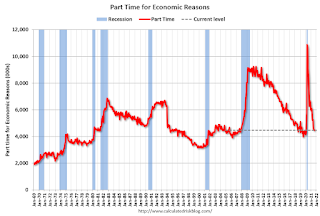by Calculated Risk on 10/08/2021 09:12:00 AM
Friday, October 08, 2021
Comments on September Employment Report
The headline jobs number in the September employment report was well below expectations, however employment for the previous two months was revised up significantly. The participation rate declined, and the unemployment rate decreased to 4.8%.
Leisure and hospitality gained 74 thousand jobs in September. In March and April of 2020, leisure and hospitality lost 8.2 million jobs, and are now down 1.6 million jobs since February 2020. So leisure and hospitality has now added back about 80% of the jobs lost in March and April 2020.
Construction employment increased 22 thousand, and manufacturing added 26 thousand jobs.
NOTE: State and Local education lost 161 thousand jobs, seasonally adjusted, versus expectations of a solid gain. This was a key contributor to the weak job report.
Earlier: September Employment Report: 194 Thousand Jobs, 4.8% Unemployment Rate
In September, the year-over-year employment change was 5.7 million jobs. This turned positive in April due to the sharp jobs losses in April 2020.
Permanent Job Losers
 Click on graph for larger image.
Click on graph for larger image.
This graph shows permanent job losers as a percent of the pre-recession peak in employment through the report today. (ht Joe Weisenthal at Bloomberg).
Earlier: September Employment Report: 194 Thousand Jobs, 4.8% Unemployment Rate
In September, the year-over-year employment change was 5.7 million jobs. This turned positive in April due to the sharp jobs losses in April 2020.
Permanent Job Losers
 Click on graph for larger image.
Click on graph for larger image.This graph shows permanent job losers as a percent of the pre-recession peak in employment through the report today. (ht Joe Weisenthal at Bloomberg).
This data is only available back to 1994, so there is only data for three recessions.
In September, the number of permanent job losers decreased to 2.251 million from 2.487 million in August.
In September, the number of permanent job losers decreased to 2.251 million from 2.487 million in August.
These jobs will likely be the hardest to recover, so it is a positive that the number of permanent job losers is declining rapidly.
Prime (25 to 54 Years Old) Participation
 Since the overall participation rate has declined due to cyclical (recession) and demographic (aging population, younger people staying in school) reasons, here is the employment-population ratio for the key working age group: 25 to 54 years old.
Since the overall participation rate has declined due to cyclical (recession) and demographic (aging population, younger people staying in school) reasons, here is the employment-population ratio for the key working age group: 25 to 54 years old.The prime working age will be key as the economy recovers.
The 25 to 54 participation rate decreased in September to 81.6% from 81.8% in August, and the 25 to 54 employment population ratio was unchanged at 78.0% from 78.0% in August.
Part Time for Economic Reasons
 From the BLS report:
From the BLS report:"In September, the number of persons employed part time for economic reasons, at 4.5 million, was essentially unchanged for the second month in a row. There were 4.4 million persons in this category in February 2020. These individuals, who would have preferred full-time employment, were working part time because their hours had been reduced or they were unable to find full-time jobs."The number of persons working part time for economic reasons was essentially unchanged in September at 4.468 million from 4.469 million in August. This is back close to pre-recession levels.
These workers are included in the alternate measure of labor underutilization (U-6) that decreased to 8.5% from 8.8% in August. This is down from the record high in April 22.9% for this measure since 1994. This measure was at 7.0% in February 2020 (pre-pandemic).
Unemployed over 26 Weeks
 This graph shows the number of workers unemployed for 27 weeks or more.
This graph shows the number of workers unemployed for 27 weeks or more. According to the BLS, there are 2.683 million workers who have been unemployed for more than 26 weeks and still want a job, down from 3.179 million in August.
This does not include all the people that left the labor force.
Summary:
The headline monthly jobs number was well below expectations, however the previous two months were revised up by 169,000 combined. And the headline unemployment rate decreased to 4.8%.
There was some good news - the decline in the unemployment rate, the decline in permanent job losers, and the decline in long term unemployed - however, there are still 5.0 million fewer jobs than prior to the recession, and overall this was a disappointing report, probably due to the sharp increase in COVID cases in September.


